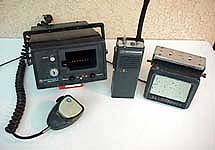
HT220 Converta Com Model
Converta Com article contributed by Chris Arndt, KD6DSI

The Converta Com model has a special front case with electrical contacts below the speaker. It slides into a mobile charger that has battery charging circuitry and a PA in it to boost the transmit power, along with a regular mobile unit microphone and speaker, and an external antenna. Once slid into the base, the radio could be retained with a keylock to avoid theft.
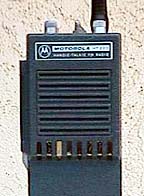
The HT220 has a special front with 8 contacts molded into it under the speaker grill. These contacts mate with spring contacts in the pocket of the docking unit, passing TX and RX audio, RF, etc. There is also a metal plate above the PTT button, for the pocket retaining mechanism. The charging contacts are at the bottom of the pocket, and use the standard HT220 case contacts. The HT probably has a switching relay inside of it to switch the unit from handheld to mobile service.
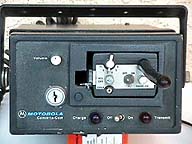
The HT220 slides into the pocket on the base, and is held in place by the retaining device. Pressing the blue button causes the HT to spring out slighlty so it can be removed. The standard Motorola key lock locks the HT in place for theft prevention. The silver knob is the base volume control. You can see the contacts inside the empty pocket.
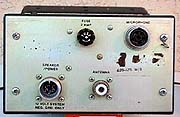
The antenna, mike, and power/speaker connections are on the back of the base. This base is stamped for UHF, but works on VHF, so this unit was probaly made up of parts of other Converta-Coms.
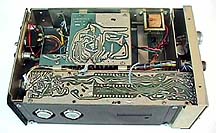
Inside the converta com are the power supply, RF, audio, and switching circuits to convert the radio from a handheld to mobile unit. The power supply has to step up nominal 13.8 VDC to the 15V voltage required to charge the HT's battery. I'm not sure how many RF watts the base puts out.
Public Safety Model
![[HT-220 Public Safety Model]](ht2213.jpg)
Designed specifically for public safety and security personnel, this model has a remote speaker/mic/antenna to allow operation without removing the radio from belt and provide best possible radiation pattern.
Factory Battery Tester
Among the seldom-seen optional accessories is the factory Battery Tester. This unit looks like the single-unit drop-in charger but with a analog meter (0 to 17 volts). Motorola anticipated a customer could have both high and low power versions of the "Omni" HT220, and provided the appropriate slot and a resistive "load" selected by the "hi" or "lo" button, representing the current drawn by the 1.8 watt or 5 watt transmitters. The tester thus minimized the need to have the actual radio in the test slot, since the battery itself could be dropped in, just as with the charging units. It also came with external DC test jack terminals.
Motorola's shift toward PLL and microprocessor-based portables caused some dissent among potential and subsequent customers because of the noticeably higher current draw and shorter battery life compared with the HT220. Indeed, with the advent of the modular MT500 and early complaints about how piggy the radios were with batteries, the company's National Sales department was reportedly told to stress the "energy saving" nature of the successor "MX" series radios, which ran on a 7.5 volt operating voltage, compared to the 15 volt operating voltage of the old HT220 (and MT500). What was intended to be left out of such a pre-emptive discussion is that the overall power consumption remained higher on the new radio (simple Ohm's law). Even with the latest energy-saving circuits which cycle a receiver's circuit on and off until a desired signal comes in, the HT220 receiver remains one of the most energy conservative hand-helds ever made.
Some Rare Options
![[HT-220 dual PL encoder-decoder]](ht2207.jpg)
On the left upper is Motorola's rare dual PL encoder-decoder board for the HT220, allowing different transmit and receive tones. This board mounts in the extended" sleeve area of an "Omni" thickness radio and can also be installed in what started out as a "carrier length" Omni HT220.
The standard "Vibrasponder" unit is twice the size of these miniature versions, and takes up nearly all the space in the PL-area of a standard configuration radio. Usually the on-off PL switch on the top panel of the radio selects only whether the receiver is carrier- or tone-squelch. The transmit audio always includes the subaudible tone. It would be left to the experimenter to devise a way to affect the transmitted tone, or to configure the receive PL switch to select between the two Vibrasponder tones available with this module.
On the upper right is the six-channel board. Although this is a standard Motorola board, it seldom was used in what Motorola considered a full channel "Omni" configuration radio because it precludes the use of the popular 5-watt amplifier module. The amp sits in half of the extended sleeve area, and this board would take up more than half the space. It was generally used with the low power (1.8 watt) model, retaining an ease of crystal tune-up to the desired frequency.
For high powered models, Motorola (at the factory) or the savvy outside bench technician retrofitting such a radio would use the two channels (four crystal locations) available on the motherboard, and acquire a four-channel Motorola board (not shown). The six-position channel selection switch never knew the difference and the markings on the top plate and knob matched the radio's abilities. Configured this way, it was difficult to adjust the motherboard crystals since the tuning is somewhat dependent on having the entire radio compressed as if it were in use (see tuneup aid that follows). The factory did not offer an eight-position switch for those who preferred channel capacity over other options, but some hams accomplished that by directly buying such a switch from Grayhill, the subcontractor.
Tuning Aid
![[HT-220 Tuning Aid]](ht2209.jpg)
The unit on the right is one of two factory tuning aids designed to compress the radio's front plastic and metal chassis, while also connecting the RF tab on the motherboard to a threaded RF output. The second aid (not shown) covers the very top of where the back cover would normally go on either the Slimline or the Omni. The compression afforded by these aids replicates an assembled radio. Frequency tuning of the crystals is affected by the tightness of the case screws, and there is a Motorola torque specification applicable to both the assembled case and the use of these aids.
Board types to look for
![[HT-220 Board Types]](ht2208.jpg)
The oldest examples of the HT220 had problems with printed circuit foil lifting from the insulating material of the motherboard. This generally happened when the radio was repaired or when crystals were changed. Original, unmodified radios are difficult to find on the used market in the 30 years since they were manufactured, but Motorola did change the type of insulating board material in an effort to respond to the problem. Consequently, the interested buyer would do well to seek out the tan board seen on the left in the image, and check carefully before considering the green board on the right. There was a lot of mixing-and-matching among boards and subassemblies, making it difficult to conclude which motherboard is inside from any external cues. Shown on the left is a two-channel, carrier-squelch "E" board front housing (the only one with an earphone jack on the front edge), an "E" board tan motherboard, the "Omni" extension sleeve, and an older green board 5 watt amplifier module. On the right is an early, two-channel, carrier-squelch slimline with green board, revealing the RF tab in the lower right of the motherboard to which the test aid or back cover connects with the threaded antenna mount.
Marine Model
This was the one all the hams wanted because of its selectable high-low power. Motorola decided to develop and market this model for the new VHF marine band (156 MHz) which replaced in the 1970s the old shortwave marine band (2 MHz, just above AM broadcast).
Using a specially-designed 5 watt amplifier controlled with a top panel switch, this option offered extended battery conservation on low power, while allowing the user to boost when needed the transmit power to a full 5 watts.
It was not possible for Motorola to simply market to maritime interests the high-powered version of the HT220. The FCC regulations governing the simplex (non-relayed) channels of the VHF marine band mandate a power level of one watt or less in harbor areas to minimize interference among boaters. Outside the harbor, power of up to 25 watts is permitted.
The "marine" HT220 was thus able to comply with the law, winning type acceptance but not market acceptance. At a price of more than $1000, few boaters would consider Motorola's handheld marine radio, which covered only six of the dozens of new channels available. The wealthiest boaters bought full-sized units, and small-time boaters did without. In the years since, radio manufacturers have brought synthesized, all-channel VHF marine band portables down to about the $100 range. Few examples of this Motorola model have ever been seen.
Motorola's design was such that the RF output of the transmit side of the motherboard is detuned to about 500 milliwatts for a proper drive level to the amplifier module, as with the non-switchable amp, and thus becomes the "low" power level in operation. When selected, the motherboard output feeds past the high-power module effectively out of the circuit. On high power, the amp module is driven by the motherboard as with any high powered HT220 to about 5 watts. The amplifier is broadbanded and easily retunes downward to the 146 MHz ham band, where FM repeaters typically are used for wide coverage. In difficult coverage areas, the "high" power choice makes the difference at being heard.
Secret Service Model
![[HT-220 Secret Service Model]](ht2205.jpg)
Before we get to the rare beast shown, some background is in order. Fans of the HT220 have long known about a type of upper rear cover for the Slimline model which came to be known as the "Secret Service back." This cover was a thicker piece of upper plastic allowing the installation and use of some special circuits the agency used that otherwise would not fit in the tactical version of this radio. The back included two sub-miniature jacks.
The Secret Service was among the first government users to buy in quantity the "remote only" version of the Slimline HT220. The agency used it with its own coat sleeve-mounted mic and push-to-talk, along with a low-profile earpiece now synonymous with being anonymous as an agent on a protective detail. It is ideal for survelliance operations such as stake-outs, parades, political rallies, etc. -- any place where discreet communications are desired.
![[HT-220 Secret Service Model]](ht2206.jpg)
Hams could purchase this empty shell of a back, and could use it with multi-channel frequency boards created by the aftermarket which enabled the user to install as many as six channels in a Slimline model. It kept the unit a slender little radio, for sure, at a time the Amateur market had to settle for book-sized Drake TR22's or bulky Wilson or Tempo crystal-controlled handhelds.
Later, but near the end of the HT220's reign at the White House, the Secret Service ordered from Motorola some custom thickness front covers, with a stock factory speaker, for use with an agency-developed circuit board. The color and surface grain pattern is identical to a stock front, but no Motorola logo was included.
This expanded Slimline radio was used with the first version of a White House secure communications system involving multiple encryption codes used on transmit and receive, both simplex and through agency repeaters. After some prototype testing of a few radios around Washington, the agency eventually expanded the system nationwide.
Shown is one of the few examples of the radio ever to make it to private hands. The HT220 was, later replaced in the Protective Division with other Motorola models.
Medical HT220
![[HT-220 Medical]](ht2210.jpg)
This particular version included a telemetry-capable of sending ECG data to a hospital. Motorola parts literature and sales brochures identify this Omni, E-Board HT220, with a RED plastic case. However, this unit was also manufactured in the standard stellar blue case. The unit was marketed for use by ambulance crews with electrocardiogram and other measuring instruments, whose data could be radioed to the hospital while en route. This model has a ID tag of H33FFN3110B-SP1, however, this may have been from another unit because H33 identifies it as a VHF but the radio is a UHF. The HT220 is notorious for being mis-identified when backcovers are swapped. It has two PL settings and has 8 channels.
![[HT-220 Medical top]](ht2210b.jpg)
The unit is a remote speaker/mic since the inside front cover has the ECG electronics (note there is no speaker grill on the front cover), and adds more thickness to the front which is somewhat cumbersome for slipping into your back pocket. The extension sleeve consists of all crystals (8 receive, 8 transmit for a total of 16) so there is not even room for a collapsible antenna inside. The top panel shows the channel switch, volume, squelch, PL switch (left for PL1 and right for PL2), speaker receptacle, ECG leads receptacle, and a control switch for ECG / VOICE / CAL. The VOICE is for normal 2-way communications, ECG puts the unit into transmitting ECG data, the CAL position puts the unit into transmitting a calibrated signal (it sounds like "eeee oooooo eeeee ooooooo eeeeeeeee ...").
Touch-Tone HT220
![[HT-220 Touch-Tone]](ht2211.jpg)
![[HT-220 Touch-Tone top]](ht2211b.jpg)
Many hams attach a dual-tone "Touch Tone" pad to the front of their HT220s but Motorola has manufactured front covers with a dual-tone pad. The pad is below the speaker grill and adds a little more thickness to the front of the radio, like the Medical HT-220, is cumbersome for slipping into your back pocket. The switches are individual weatherproof buttons. This particular unit, model H24FFN3191D-SP94, is a six-channel and also has Select-Call (paging) option. To use the dual-tone pad, you would hold the transmit button and "dial a number."